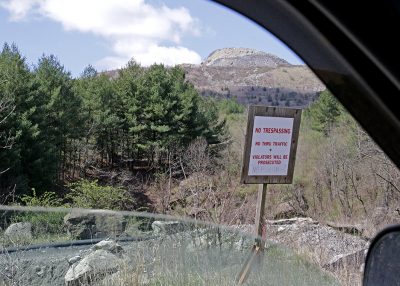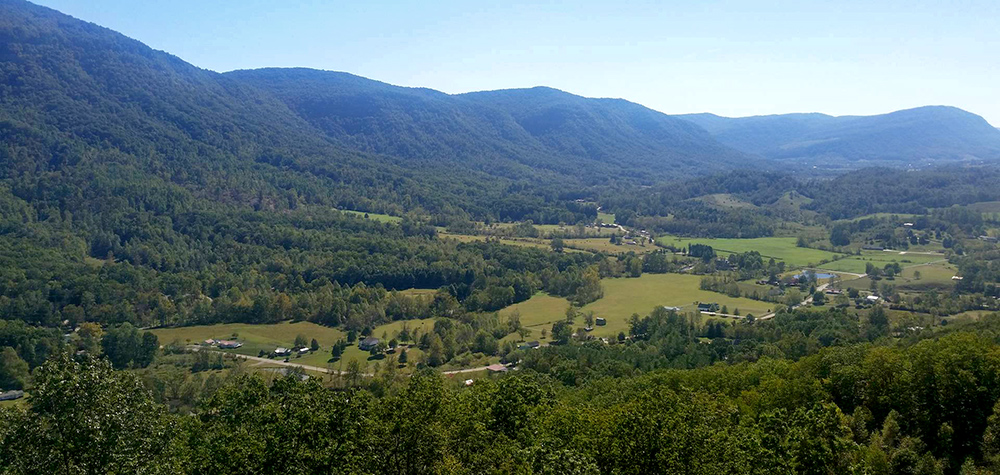Front Porch Blog
Special Series: The Land Matrix
Appalachian Voices is proud to present a series of blogs in the coming months about land ownership in Appalachia and how it impacts efforts to diversify the region’s economy. The author is Terran Young, a Wise County native, herbalist, film producer and mental health advocate. Terran is currently serving as a Highlander Appalachian Transition Fellow working in partnership with Appalachian Voices, Southern Appalachian Mountain Stewards and LiKEN Network.
As a Highlander Appalachian Transition Fellow, my job for the year is to delve into the complexities of the Land Matrix in Central Appalachia, and in particular, Wise County in southwestern Virginia.
What is the Land Matrix? It is the current structure of land ownership, use and distribution, and everyone and everything that supports that structure, knowingly or unknowingly, to keep it in place. This includes businesses; local, state and federal governments; local residents; plants and animals; and, of course, the land itself.
Yes, as I said, it is complex. Let me break things down and take a step-by-step approach to unraveling this complicated system. The overall plan of the project is, at the very least, to change the way we all think about land and land ownership patterns. Those of us who are extremely optimistic would love to see a change in the land ownership patterns themselves. Using this series of blogs, I would like to take some time to look into a few of those structures in the Land Matrix and openly brainstorm some ideas.
A July 2017 article in Yes magazine describes some of the issues with the current patterns of land ownership and how the regional Appalachian Land Study addresses those issues. Read More
Appalachia is in transition. TRANSITION. That’s the buzzword of the moment. And I am an Appalachian Transition Fellow. But what does that mean exactly? What are we transitioning away from? What are we transitioning towards? How does this transition fit into the Land Matrix?
Appalachia has had an extractive coal economy for more than a century. Like all non-sustainable industries, the product eventually runs out. Aside from a few booms here and there, it is apparent to most that the coal industry probably won’t be around too far in the future. So Appalachia has already, and not always willingly, begun its transition away from a coal economy. The issue with transition is you have to have a plan and direction. For Appalachia to have a successful transition into anything at all, that plan has to start with a change in the Land Matrix.
Okay, so what is that change? Wise County is 405 square miles. At the moment, at least 70% of the land is owned by corporations outside of the state. That leaves less than 30% for citizens of Wise County. The county assesses corporate land at a lower value than residential, even though the tax rate is the same — at 60-cents per $100. For example, XYZ Land Holding Corp., that owns 400 acres pays less in taxes per square-foot than I do for my half-acre property with my house. This is due to highest and best use principles which I will get into with more detail in an upcoming blog.
A change would be a drastic flip in a different direction. A change would be seeing more local land in the hands of local people for private use like homes, farms and small businesses, and for locally owned public spaces and commons such as community gardens and parks for eco-tourism.
The first step in unraveling the complexities of the Land Matrix would be to identify the stakeholders, the people who would be affected by this change. I have divided the stakeholders into five categories — county government, federal government, local businesses, outside/absentee corporations and local residents.
The Wise County government would benefit from revenue of a tax structure that benefits local business over outside corporations, especially if those corporations aren’t providing many local jobs. Outside corporations on the other hand, would probably protest having a higher tax rate since their currently low taxes make Wise County ideal for their operations, and might even be willing give up or sell their land. For local businesses, a change in the structure would mean lower taxes for them and access to more land to expand, especially for agricultural operations.
The local residents of Wise County would benefit most of all. I can personally account for how difficult it is to find a nice piece of flat land for purchase to build a home. With a transition in the Land Matrix, potentially making more of that 70% of outside-owned land available, people who don’t have large areas of land could start community gardens. Environmental groups like Southern Appalachian Mountain Stewards and The Clinch Coalition could help preserve land and give nature walks and tours.
One part of the Land Matrix that I have not addressed is the U.S. Forest Service and George Washington and Jefferson National Forests. This includes almost 36,000 acres of land in Wise County alone. The Jefferson National Forest allows a place for recreation and offers designated times for fishing and hunting. The gathering of fruits, nuts, pine cones and mushrooms is allowed without the need for a permit, while firewood and plants require a permit. Both ginseng collection, due to overharvesting, and rock collection, because rocks are non-renewable, are not allowed. Currently, this aspect of the Land Matrix works well and is beneficial to the current structure.
While the idea of making a drastic change to southwest Virginia’s land ownership structure could have a positive effect on the majority of the stakeholders mentioned… making it actually happen is as complex as the Land Matrix itself.
Stay tuned for my next blog where I’ll explore who sets the tax rate and look into some of the top landowners in the county.
To learn more about the Appalachian Land Study, contact Terran at SWVALandStudy@gmail.com
PREVIOUS
NEXT
Related News

Leave a comment
Your email address will not be published. Required fields are marked *




When is your next report?
Thanks Terran for your work on this! This is a very important issue for the people of Applachia, SW Va! The land should belong to the citizens who live in the local area!
Great write up! More people need to know this kind of stuff. It gives the citizens a different perspective!
I’ve always wondered about this, thanks for publishing. Looking forward to more detail.
Be sure to address the issue of the various land rights which are often split out, such as mining and oil. That is a problem in my area, even for natural areas.
Well done Terran. Thanks for putting this together and setting out the initial information so cogently. I look forward to your upcoming blog posts.
Such an interesting way to look at land in a specific county. Thanks.
Very interested in following your blog. I was Ky. State Coordinator of the 1981 Appalachian Land Ownership Study.
I like the way you are approaching this task.